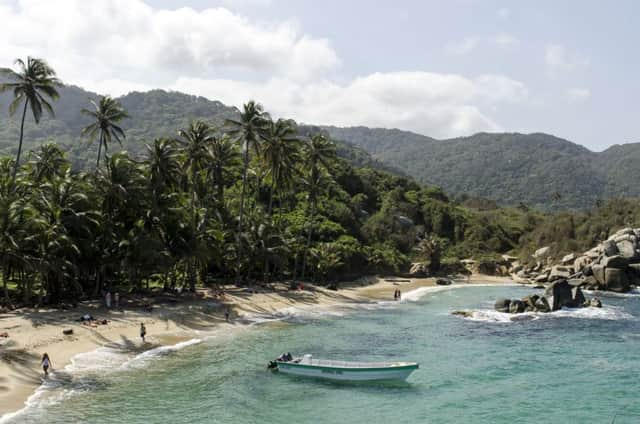Colombia: Paradise found


Despite the clammy 35C degree January heat, I put on my trousers; the same sweaty, permanently damp pair that I’ve been hiking in for the past two days. But I shouldn’t be surprised; thick clouds of spindly-legged and vicious (but not malarial) insects are just one of the deterrents facing trekkers hoping to reach Colombia’s Ciudad Perdida (Lost City).
Founded in 800AD, the mountaintop citadel was abandoned by the ancient Tayrona civilisation in the 16th century when the Spanish conquistadors reached coastal city Santa Marta. Rodrigo de Bastidas and his men never made it here, but the deserted settlement remained hidden for several centuries, until looters found a series of staircases in 1973 and dubbed the place “green hell”.
Advertisement
Hide AdAdvertisement
Hide AdIn 1976 the Colombian Institute of Anthropology and History stepped in, but it took several helicopter searches to relocate the overgrown ruins.
Since the early Eighties, tourists have attempted the arduous but overwhelmingly spiritual 44km hike to Ciudad Perdida, although a kidnapping incident in 2003 put the site off limits to British travellers for several years. Now guerilla activity has subsided in Colombia, and while visitor figures are climbing, the enchanting trail is still far enough off the beaten track to appeal to adventurous travellers.
Basing myself at the seaside Hotel Arhuaco means I’m already halfway through my journey into the Sierra Nevada mountain range, which rises 5,700m above the Caribbean coastline, but more leisurely hikers can choose to do the trip in six days.
Sweat pours from me as I haul myself up never-ending inclines, yet I only need to stop for a few minutes and look around to understand why I’m doing this. With thin vines trailing from branches like angel hair and hummingbirds zipping across clear mountain streams, it truly is a pristine paradise.
Advertisement
Hide AdAdvertisement
Hide AdI’ve allowed myself one change of clean clothes, and I save those (as a treat) to sleep in.
The campsites en route are maintained by the wiwas and kogis, indigenous tribes descended from the Tayrona civilization. Nearly 40 kogi families live in the Mutanzhi village, close to the trail, and receive money from the government for every tourist making the Lost City trek.
The kogis have a gentle disposition but I get the impression outsiders are merely tolerated. Every September, the park closes for two weeks for a purification ceremony and I imagine this is when the community is most at peace.
When we finally reach the uninhabited Lost City, after a final hamstring-straining 1,200 stone step climb, I can appreciate why, with 69 terraces carved into the mountainside, it was once an empire in the sky.
Advertisement
Hide AdAdvertisement
Hide AdOnly 30 per cent of the original site has been uncovered, so don’t expect anything similar to the complexity of Machu Picchu, but the silence and seclusion is worth every blistering mosquito bite.
A few Colombian army officials are a reminder of the terrorist threat that once plagued these mountains, but with my legs dangling above plunging forest slopes, I imagine the ocelots, pumas, jaguars and 600 species of birds that have reclaimed this biosphere as their own.
The kogi people are deeply connected to nature and the development of tourism in their sacred homeland is a delicate matter. It’s more acutely obvious in Pueblito, an ancient village in Tayrona National Park, where I head to recover after the Lost City trek.
A 50-minute walk from the nearest car park, the Ecohabs Cabanas Arrecifes (a cluster of boutique tourist huts) is buried deep in the park at the foot of the mountains overlooking the Caribbean Sea.
Advertisement
Hide AdAdvertisement
Hide AdPelicans soar overhead as fierce waves extend their grip along shores largely unsuitable for swimming, but where smooth granite boulders and delicate palm fronds draw comparisons with the Seychelles.
It takes an hour and a half to reach Pueblito from El Cabo beach, scrambling up a rocky stairway where ropes tied to tree trunks can be used in tougher sections. (An easier although arguably no less “treacherous” trail runs through the neighbouring nudist beach.)
Manuel and his family make up half the village, which has dwindled in recent years, due largely to a lack of privacy. We sit outside his home, chatting, as tourists in disrespectfully small bikinis peer through the windows of his circular thatched home as if it’s a museum exhibit.
“They come to this place, don’t help, leave lots of rubbish and I don’t like it,” he grumbles in Spanish, although he says he’s happy to welcome responsible visitors.
Advertisement
Hide AdAdvertisement
Hide AdHe goes on to complain about a “contamination” that first came with the conquistadors, and I know he’s referring to a disease far more harmful than smallpox or tuberculosis.
Perhaps those clouds of mosquitoes serve some purpose after all: the real beauty of Ciudad Perdida is clearly in its name.
• Sarah Marshall was a guest of HighLives (020 8144 2629, www.highlives.co.uk) which offers a 10-day private tour of Colombia from £2,100 per person. The tour includes two days in Cartagena, four days private Ciudad Perdida trek, two days in Tayrona National Park and two days in Bogota. The price includes B&B accommodation in three star hotels, English speaking local guides and transfers.
Air France (www.airfrance.co.uk) offers a daily flight to Bogota, Colombia, via Paris from 10 UK airports. Return fares start from £386 including all taxes and fees.